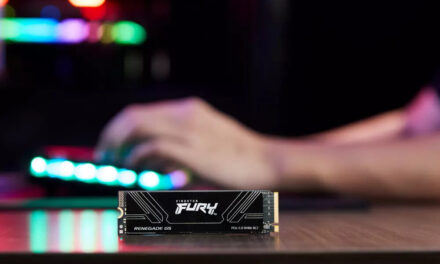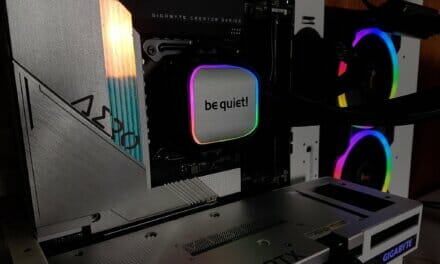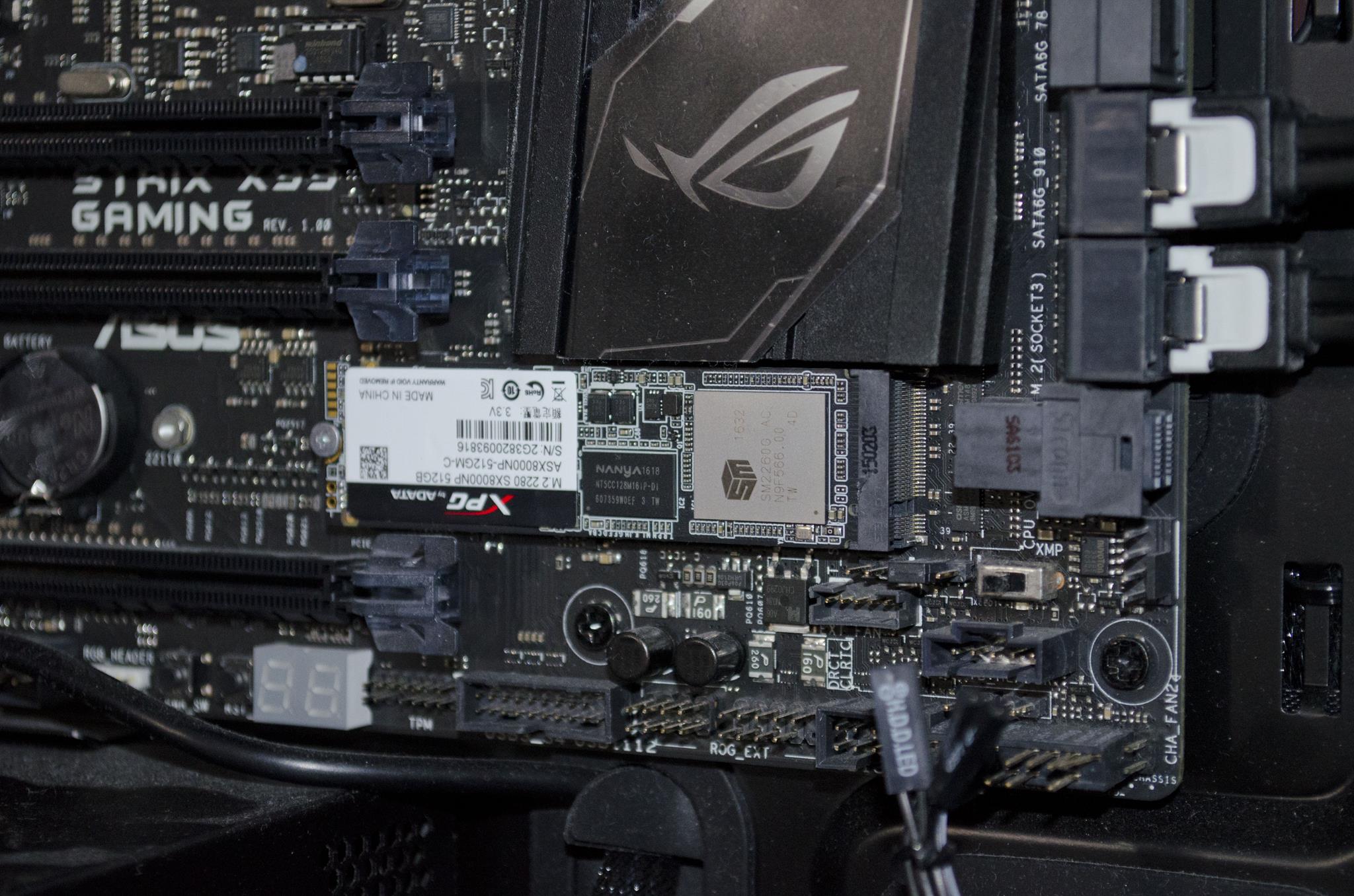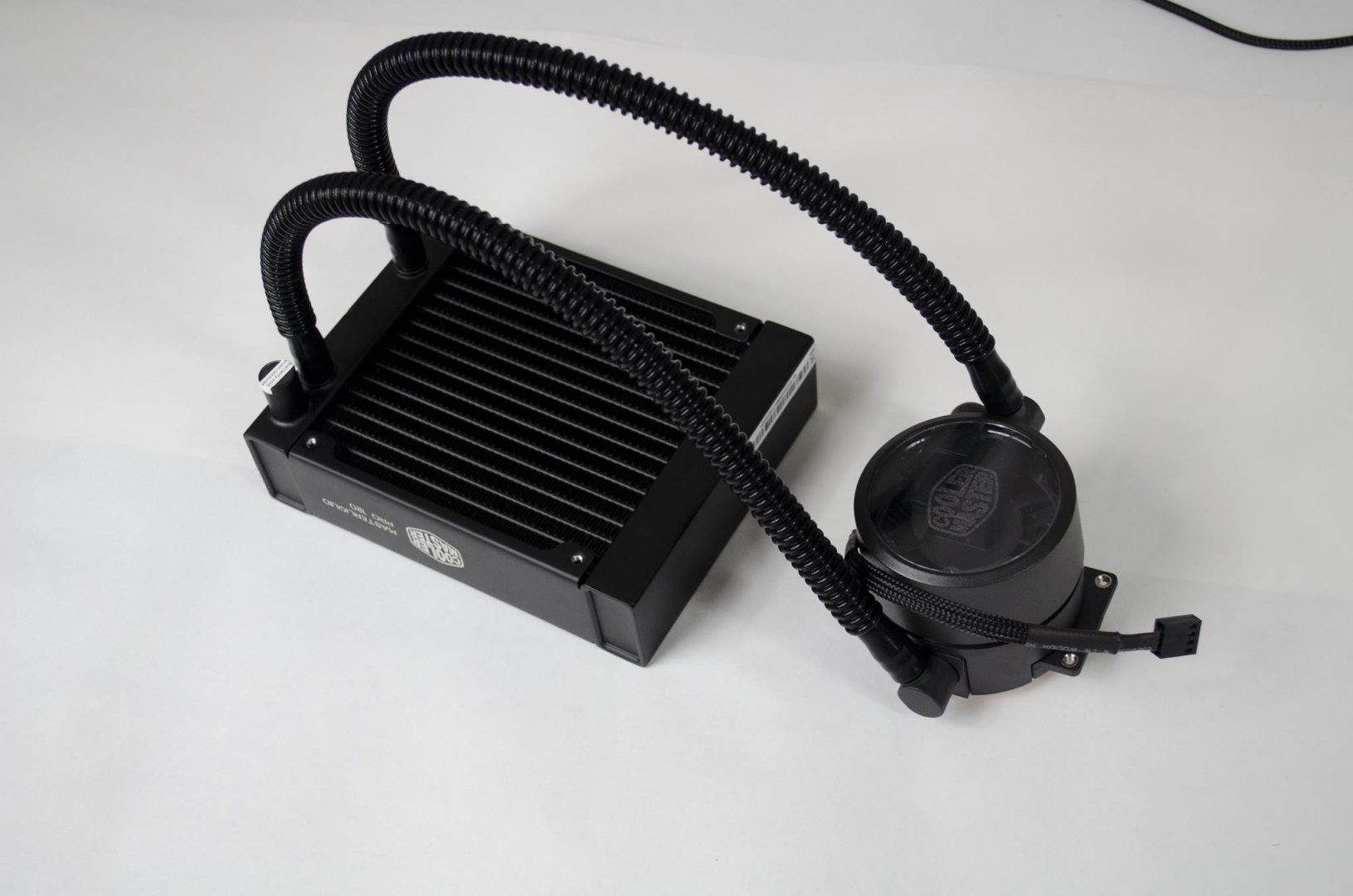
Sabrent Rocket 4 Plus NVMe 4.0 2TB [SB-RKT4P-2TB] Review
![Sabrent Rocket 4 Plus NVMe 4.0 2TB [SB-RKT4P-2TB] Review](https://www.enostech.com/wp-content/uploads/2022/02/20220210_180549-Copy-1280x640.jpg)
Introduction
Earlier we have taken a look at the budget segment fast-storage solution in the form of Rocket Q NVMe 500GB SSD from Sabrent. This time we are peeking at the high-performance, feature-rich, super-fast storage solution from Sabrent. It is called Rocket 4 Plus PCIE 4.0 NVMe 2TB SSD. Sabrent is labeling this SSD as “The World’s Fastest NVMe SSD”. A bold claim for sure but this SSD packs quite a solid punch. So, let’s dig in!
This SSD is based on PCIe Gen 4 utilizing the 4 lanes. The quite intrinsic element of this SSD is the super-fast data transfer rates. Sabrent has shown this drive to reach up to whopping 7000 MB/s sequential reads and up to 6850 MB/s sequential writes when connected to the PCIe Gen 4 enabled M.2 port. It is backward compatible with the PCIe Gen 3 but with reduced speeds which is obvious. We can expect a sequential read speed of up to 3400MB/s and 3000MB/s sequential write speed on PCIe 3×4.
Enough said for the sequential speeds. What about the 4k random numbers? Well, this SSD is rated for up to 650K IOPS under 4K Random QD32 reads and 700k IOPS under 4K Random QD32 writes. This SSD is all about numbers and performance.
Product: Sabrent Rocket 4 Plus PICe 4.0 NVMe 2TB [SB-RKT4P-2TB]
Price: $309.99 [At the time of the review]
Specifications
Packaging and Unboxing
The drive is shipped inside a paperboard-based packing box which is finished in a copper color theme.
This drive is using TLC NAND Flash chips and has a 2TB capacity. “Advanced Performance” tag is highlighting that Sabrent is aiming this SSD to the enthusiasts, professionals, gamers alike who would not want any compromise.
The exact model is SB-RKT4P-2TB. Pay attention to model number, particularly for the Rocket Plus series SSDs.
There is a hard closure inside the main packing box. It has a sticker label on both sides.
The above picture shows the opposite side of the hard closure.
Needless to say, Sabrent has my praise for some impressive presentation in packing.
Opening the closure would show the user guide and the SSD along with the SSD cover.
Closer Look
The Rocket 4 Plus is a different breed as compared to the Rocket Q. While the Rocket Q reaps the benefits of the QLC enabling the series to reach speed up to 8TB and aims at the budget users at best, the Rocket 4 Plus is aimed for the enthusiasts and professionals who would want nothing but the best. This series is using 3D TLC NAND Flash. The maximum capacity available in this series is 4TB. Obviously, cost considerations are there. TLC stores 3 bits per cell as compared to the other NAND flash.
The Sabrent Rocket 4 Plus NVMe PCIe 4×4 2TB SSD has an M.2 form factor of 2280. It is an M Key type SSD compatible with the majority of the M.2 slots on modern motherboards. It is also backward compatible with the PCIe Gen 3 but with reduced speeds.
The dimension of the SSD is 80x22x3.65 (LxWxH) and it has a weight of 2.4Oz. The Sabrent Rocket 4 Plus series SSDs don’t need a dedicated driver on Microsoft Windows 8.1 and 10. Since these SSDs are using the operating system’s native NVMe driver, there is no dedicated software either by the manufacturer.
There is a copper color sticker cover with black accent Sabrent branding. This would be a handy dandy for the black/neutral-themed builds. The drive in consideration has 2TB capacity and is PCIe Gen4 based using 4 PCIe lanes for connectivity.
The operating temperature of these drives is 0°C to 70°C whereas the storage temperature requirement is -40°C to 85°C. These have a shock resistance of 1500G. The MTBF is mentioned to be 1,600,000 hours. If you would have read our take on the Rocket Q 500GB SSD, then you would know that SSD has an MTBF of 1,800,000 hours. The SSD comes with a 1-year warranty which can be made 5 years but only with the registration. The TBW (Terrabytes Written) value is mentioned to be 1400 TB meaning we roughly get a guaranteed of 280 TB per year in 5 years warranty. Not bad at all.
Coming to the magic of numbers which the users would love to know, this SSD is rated to do up to 7000 MB/s sequential read speed and up to 6850 MB/s sequential write speed when connected on PCIe Gen 4 enabled port. Coming to 4K stats, this SSD is rated for up to 650K IOPS in Random 4K Read and 750K IOPS Random 4K Writes. These numbers are provided based on a Queue Depth of 32. These are quite good numbers in this class.
There is a white color large size sticker on the back. It has a part number and a serial number of the drive printed. The drive is rated to draw 7.3W for Read operation and 8.2W for write operations. The power supply is rated at 3.3V.
The Rocket 4 Plus NVMe PCIe 2TB is a dual-sided SSD meaning the components are on both sides of the PCB. When we say components, we mean the controller, DRAM, NAND Flash, and circuitry.
Take a close look at the above picture. The top sticker paper is on a thin layer of copper color heatsink. I would not remove the top cover for that matter.
Speaking of features, this SSD has:
- NVMe M.2 PCIe Gen4 x4 Interface.
- PCIe 4.0 Compliant / NVMe 1.3 Compliant.
- Power Management Support for APST / ASPM / L1.2.
- Supports SMART and TRIM commands.
- Supports ONFi 2.3, ONFi 3.0, ONFi 3.2 and ONFi 4.0 interface.
- Advanced Wear Leveling, Bad Block Management, Error Correction Code, and Over-Provision.
- Upgradeable Firmware.
Speaking of the components, the Rocket 4 Plus 2TB NVMe PCIe SSD is powered by the powerhouse Phison E18 controller. This controller can be found in the majority of the high-range SSDs. This controller is based on TSMC 12nm process technology using a 32bit ARM Cortex R5 micro-controller in Triple-CPU architecture with up to 8 channel support. The controller has support for Dynamic SLC Cache and supports 1600MT per channel in DDR4 DRAM.
This SSD packs 8x 3D TLC NAND chips from Micron. Each chip has a 250GB capacity. We have a DDR4 SDRAM 8Gbit 512M X 16 1.2V 96-Pin FBGA from SKHynix. The H5AN8G6NCJR is an 8Gb CMOS Double Data Rate IV (DDR4) Synchronous DRAM, which is suited for the main memory applications requiring high density and high bandwidth.
The above picture shows the ADIA64 Extreme’s S.M.A.R.T status of the Rocket 4 Plus 2TB NVMe PCIe SSD.
Control Panel
Sabrent provides a free copy of Acronis True Image software with the purchase of their SSDs. There is also a utility called Control Panel which can be downloaded from their downloads section.
This is a simple-to-use utility with some key readouts. It shows the temperature of the selected drive. There are shortcuts to the Microsoft Windows commands like Device Manager, Disk Management for example.
Click on Disk Info and the utility will provide a summary of the selected disk. Here we are showing the readout of the Rocket 4 Plus 2TB SSD.
There is also a built-in quick Speed test benchmark in this panel. The above picture shows the SMART values of the Rocket 4 Plus 2TB SSD.
Testing
We are still waiting for our Z690 motherboard from the GIGABYTE. Hence, we have used the Z590 platform with the following configuration:
- Intel i5 11600k
- ASUS ROG Strix Z590-A Gaming WiFi
- XPG SpectriX 16GB 2666MHz DDR4 kit
- DeepCool Castle 240EX White
- Addlink S68 250GB SSD [OS Drive]
- Nvidia GeForce GTX 1080 FE
- be quiet! Straight Power 11 850W Platinum PSU
We have used the following software:
- AS SSD 1.8.5636.37293
- ATTO Disk Benchmark 4.0
- CrystalDiskMark 6
- Anvil Pro Storage Utilities 1.1.0
- DiskBench
Microsoft Windows 10 is used for testing.
We need to first set the M.2_1 port’s link speed to Gen 4. The related setting can be found in the UEFI/BIOS under the System Agent Configuration under the Advanced tab. Click on the PCI Express Configuration to access it. Change the Gen 3 to Gen4 in the drop-down combo box if not already done.
The above picture shows the disk info of the NVMe disk in the UEFI/BOIS.
Once in the Windows environment, the disk needs to be initialized first. Access the Disk Management service. It will immediately recognize the drive and give the user to format the drive either in MBR or GPT partition style. Click on the desired style and Click on the OK button.
We now have a Basic Disk. Right-click on it and select New Simple Volume to start allocating the unused space under the volume.
Format the drive as per the user required setting.
Now, the drive is ready.
The above picture shows the Rocket 4 Plus 2TB NVMe SSD in My Computer or This PC. We have labeled the Disk as Rocket 4Plus 2TB for ease of identification.
The above picture shows the Disk properties after formatting.
Test Results
We have superb performance on the sequential read and write speeds from the Rocket 4 Plus 2TB NVMe SSD. We have good results in the 4K Q32 section as well.
Right now we have only two SSDs from different classes in the graph. As expected the Rocket 4 Plus is smashing the other driver.
The above graph compares the 4K Random Read and Write using QD32 Threaded.
Next, we run the AS SSD software to test the performance of the drive. Please, note that each stress testing software works differently and there would be variations between software and between two runs even on the same SSD. We have an overall score of 10345 from this test run which is an impressive score.
Clearly, we don’t have a comparison here as both SSDs represent different classes but Rocket 4 Plus is damn impressive.
The 4K 64 threaded result is good as well.
Impressive performance from the Rocket 4 Plus 2TB SSD.
The above is a result of the AS-SSD Copy benchmark. It shows the speed and duration of different workloads giving an idea of the real-world use scenario. Scores are self-explanatory.
The above pictures show the result of the Compression benchmark run from AS-SSD. Ideally, we would not want dips across the length of the line for both read and write operations. We are seeing a good result from the read operation but we observed two deep dips on the write operations.
Next, we ran the ATTO Disk Benchmark to test the drive’s performance. We have a maximum read (sequential) speed of 6.63 GB/s which is quite impressive. The average is above 6.2 GB/s as well on the reads. The average write is at 6.2GB/s.
No comparison at all. We will be filling these graphs in the coming time with more SSDs to make them meaningful.
Next, we ran the Anvil Storage Utilities benchmark to test the performance of the drive. On the default test size of 1GB, the tested read speed score was 8891.78. The write speed score was 16182.62 with an overall score of 25074.4.
The result is self-explanatory.
Next, we ran the IO – Threaded QD Benchmark in the Anvil. Here are the results.
We have a speed of 712740.6 with QD32 in the write operations falling a bit short on the rated 700K IOPS.
We got 857710.4 speed with a QD64 in the write operations. Impressive performance.
Next, we ran IO – Threaded operations for the read speed using different queue depths. Here are the results
We have 460964.5 IOPS. The drive falls short of the rated 650K IOPS. The reads could have been bettered.
When the queue depth was raised to 64, the speed was 649756.3 IOPS which is quite good as the result reaches close to the rated 650k IOPS mark.
With a queue depth of 128, the read speed was 773938.3.
3DMark Storage Test
3DMark Storage test is relatively a new test bench measuring the gaming only performance of the given drive using three games. It measures the load time of the games, recording the game play, saving the game, and moving the game. The overall score is given in the bandwidth and access time.
The Sabrent Rocket 4 Plus 2TB SSD did an average of 668.46MB/s and 47µs.
Again, self-explanatory result.
Real-World Testing
We have used DiskBench in multiple scenarios to check the real-world data transfer rates. Here are the results:
A compressed file of 97GB containing multiple compressed files and folders of different sizes was copied to the Rocket 4 Plus 2TB SSD. The file was then read from the DiskBench. We have a transfer rate of 2789 MB/s.
Impressive performance from the Rocket 4 Plus SSD.
Next, we copied the same compressed file from one folder to another on the same drive. The transfer rate is 2305MB/s.
Impressive feat!
Next, we copied a folder of 167GB size containing multiple compressed files, sub-folders, and mixed other files. The transfer rate was 2187MB/s.
Self-explanatory results.
The real-world transfer rates are quite impressive. Remember we are paying a premium price for this level of performance.
Gaming Load Time
Since these NVMe SSDs are also targeted towards gamers alike. We have also calculated the loading time of the game using the Final Fantasy XIV: Shadowbringers Benchmark using High settings.
We have a load time of 9.413 secs.
Thermals
We saw a maximum temperature of 72°C at an ambient temperature of 21°C on the Rocket 4 Plus 2TB NVMe SSD. We tested the SSD without any heatsink on it. The Gen 4 SSDs tend to rum warm and heatsink solution either on the motherboard or custom one would help tame the temperatures.
Conclusion
The Sabrent Rocket 4 Plus is an enthusiast-grade high-performance, super-fast storage solution from the manufacturer. This series SSDs are available in 1TB, 2TB, and 4 TB capacities. These SSDs are using 3D TLC NAND from Micron. These SSDs are reaping the full benefit of PCIe Gen 4 by utilizing 4x lanes. Hence you would need a PCIe Gen 4 enabled motherboard to take full benefit of these SSDs.
The Sabrent Rocket 4 Plus NVMe is M key type SSD using the 2280 form factor. The SSD has a sequential read speed rating of up to 72000MB/s and a sequential write speed of up to 6850 MB/s. These speeds can only be realized when on PCIe gen 4.0. These speeds would reduce to 3400MB/s and 3000MB/s read and write respectively on PCIe Gen 3.0. The 4K random read and write speed ratings are 650K and 700K IOPS respectively using QD32.
The main driving force in this SSD is a power horse from Phison in the form ofE18 controller. We have eight 3D TLC-based NAND flash chips from Micron and 8GB DDR4 DRAM from SK Hynix. This is a dual-sided layout where the components are on both sides. The top cover has a thin layer of copper in what seems like a heatsink so I would not remove it for better heat dissipation unless you have a motherboard with a heatsink by default.
The TBW rating is 1400. Sabrent is offering a 1-year warranty on this SSD. The user can register the SSD within 90 days of purchasing to get the 5-year warranty. The SSD is PCIe 4.0 compliant with NVMe 1.3 compliance. Power management support for APST/ASPM and L1.2 is provided. It supports the TRIM and SMART commands along with the ONFi 2.3, 3.0, 3.2, and 4.0 interfaces. It features Advanced Wear Leveling, Bad Block Management, Error Correction Code (Thanks to E18), and Over-Provision. The firmware of the SSD can be upgraded using the Control Panel utility. One can download this utility from the website along with a free copy of Acronis.
When it comes to the raw performance, this SSD is all about numbers and it delivers a solid sucker punch but at the premium price tag. In our testing, this drive passed the rated speeds from the manufacturer in the synthetic tests. The real-world testing is also showing impressive performance.
The Rocket 4 Plus PICe 4.0 NVMe 2TB SB-RKT4P-2TB SSD is listed at $309.99 at the time of this review. If you are a power user or a content creator or any professional for that matter whose work involves heavy workloads, the Rocket 4 Plus SSDs are there for your exact requirement with their super-fast storage speeds, features-rich, and a 5-year warranty for peace of mind.
The Sabrent 4 Plus PICe 4.0 NVMe 2TB SB-RKT4P-2TB SSD is a Must-Have from my side if you are in the marketing looking for one complete solution without any compromise. This SSD runs to love warm but can be tamed using a proper heatsink which is our next content exactly as we will be taking a look at Rocket NVMe Heatsink from Sabrent.
We are thankful to Sabrent for sending in the Rocket 4 Plus 2TB SB-RKT4P-2TB SSD for review.
















![Sabrent Rocket 4 Plus NVMe 4.0 2TB [SB-RKT4P-2TB] Review 107 Specs 1](https://www.enostech.com/wp-content/uploads/2022/02/Specs-1.png)
![Sabrent Rocket 4 Plus NVMe 4.0 2TB [SB-RKT4P-2TB] Review 108 20220211 103242 Copy](https://www.enostech.com/wp-content/uploads/2022/02/20220211_103242-Copy.jpg)
![Sabrent Rocket 4 Plus NVMe 4.0 2TB [SB-RKT4P-2TB] Review 109 20220211 103257 Copy](https://www.enostech.com/wp-content/uploads/2022/02/20220211_103257-Copy.jpg)
![Sabrent Rocket 4 Plus NVMe 4.0 2TB [SB-RKT4P-2TB] Review 110 20220210 223333 Copy](https://www.enostech.com/wp-content/uploads/2022/02/20220210_223333-Copy.jpg)
![Sabrent Rocket 4 Plus NVMe 4.0 2TB [SB-RKT4P-2TB] Review 111 20220211 103347 Copy](https://www.enostech.com/wp-content/uploads/2022/02/20220211_103347-Copy.jpg)
![Sabrent Rocket 4 Plus NVMe 4.0 2TB [SB-RKT4P-2TB] Review 112 20220211 103326 Copy](https://www.enostech.com/wp-content/uploads/2022/02/20220211_103326-Copy.jpg)
![Sabrent Rocket 4 Plus NVMe 4.0 2TB [SB-RKT4P-2TB] Review 113 20220210 223353 Copy](https://www.enostech.com/wp-content/uploads/2022/02/20220210_223353-Copy.jpg)
![Sabrent Rocket 4 Plus NVMe 4.0 2TB [SB-RKT4P-2TB] Review 114 20220210 223413 Copy](https://www.enostech.com/wp-content/uploads/2022/02/20220210_223413-Copy.jpg)
![Sabrent Rocket 4 Plus NVMe 4.0 2TB [SB-RKT4P-2TB] Review 115 20220211 103414 Copy](https://www.enostech.com/wp-content/uploads/2022/02/20220211_103414-Copy.jpg)
![Sabrent Rocket 4 Plus NVMe 4.0 2TB [SB-RKT4P-2TB] Review 116 20220211 103438 Copy](https://www.enostech.com/wp-content/uploads/2022/02/20220211_103438-Copy.jpg)
![Sabrent Rocket 4 Plus NVMe 4.0 2TB [SB-RKT4P-2TB] Review 117 Rocket 4 Plus Page Main 19](https://www.enostech.com/wp-content/uploads/2022/02/Rocket-4-Plus-Page-Main-19.png)
![Sabrent Rocket 4 Plus NVMe 4.0 2TB [SB-RKT4P-2TB] Review 118 AIDA 1](https://www.enostech.com/wp-content/uploads/2022/02/AIDA-1.png)
![Sabrent Rocket 4 Plus NVMe 4.0 2TB [SB-RKT4P-2TB] Review 119 CP 1](https://www.enostech.com/wp-content/uploads/2022/02/CP-1.png)
![Sabrent Rocket 4 Plus NVMe 4.0 2TB [SB-RKT4P-2TB] Review 120 CP 3 1](https://www.enostech.com/wp-content/uploads/2022/02/CP-3-1.jpg)
![Sabrent Rocket 4 Plus NVMe 4.0 2TB [SB-RKT4P-2TB] Review 121 CP 2 1](https://www.enostech.com/wp-content/uploads/2022/02/CP-2-1.jpg)
![Sabrent Rocket 4 Plus NVMe 4.0 2TB [SB-RKT4P-2TB] Review 122 220211091726](https://www.enostech.com/wp-content/uploads/2022/02/220211091726.jpg)
![Sabrent Rocket 4 Plus NVMe 4.0 2TB [SB-RKT4P-2TB] Review 123 220211091819](https://www.enostech.com/wp-content/uploads/2022/02/220211091819.jpg)
![Sabrent Rocket 4 Plus NVMe 4.0 2TB [SB-RKT4P-2TB] Review 124 Disk Mgmt 1 1](https://www.enostech.com/wp-content/uploads/2022/02/Disk-Mgmt-1-1.png)
![Sabrent Rocket 4 Plus NVMe 4.0 2TB [SB-RKT4P-2TB] Review 125 Disk Mgmt 2 1](https://www.enostech.com/wp-content/uploads/2022/02/Disk-Mgmt-2-1.png)
![Sabrent Rocket 4 Plus NVMe 4.0 2TB [SB-RKT4P-2TB] Review 126 Disk Mgmt 3 1](https://www.enostech.com/wp-content/uploads/2022/02/Disk-Mgmt-3-1.png)
![Sabrent Rocket 4 Plus NVMe 4.0 2TB [SB-RKT4P-2TB] Review 127 Disk Mgmt 4 1](https://www.enostech.com/wp-content/uploads/2022/02/Disk-Mgmt-4-1.png)
![Sabrent Rocket 4 Plus NVMe 4.0 2TB [SB-RKT4P-2TB] Review 128 Disk Mgmt 5](https://www.enostech.com/wp-content/uploads/2022/02/Disk-Mgmt-5.png)
![Sabrent Rocket 4 Plus NVMe 4.0 2TB [SB-RKT4P-2TB] Review 129 Disk Mgmt 6](https://www.enostech.com/wp-content/uploads/2022/02/Disk-Mgmt-6.png)
![Sabrent Rocket 4 Plus NVMe 4.0 2TB [SB-RKT4P-2TB] Review 130 CDM PCIe 4](https://www.enostech.com/wp-content/uploads/2022/02/CDM-PCIe-4.png)
![Sabrent Rocket 4 Plus NVMe 4.0 2TB [SB-RKT4P-2TB] Review 131 CDM Sequential](https://www.enostech.com/wp-content/uploads/2022/02/CDM-Sequential.png)
![Sabrent Rocket 4 Plus NVMe 4.0 2TB [SB-RKT4P-2TB] Review 132 CDM 4K](https://www.enostech.com/wp-content/uploads/2022/02/CDM-4K.png)
![Sabrent Rocket 4 Plus NVMe 4.0 2TB [SB-RKT4P-2TB] Review 133 ASSSD 1 1](https://www.enostech.com/wp-content/uploads/2022/02/ASSSD-1-1.png)
![Sabrent Rocket 4 Plus NVMe 4.0 2TB [SB-RKT4P-2TB] Review 134 AS SSD Graph](https://www.enostech.com/wp-content/uploads/2022/02/AS-SSD-Graph.png)
![Sabrent Rocket 4 Plus NVMe 4.0 2TB [SB-RKT4P-2TB] Review 135 ASSSD 2 1](https://www.enostech.com/wp-content/uploads/2022/02/ASSSD-2-1.png)
![Sabrent Rocket 4 Plus NVMe 4.0 2TB [SB-RKT4P-2TB] Review 136 AS SSD 4K Graph](https://www.enostech.com/wp-content/uploads/2022/02/AS-SSD-4K-Graph.png)
![Sabrent Rocket 4 Plus NVMe 4.0 2TB [SB-RKT4P-2TB] Review 137 ASSSD Copy](https://www.enostech.com/wp-content/uploads/2022/02/ASSSD-Copy.png)
![Sabrent Rocket 4 Plus NVMe 4.0 2TB [SB-RKT4P-2TB] Review 138 ASSSD Compression](https://www.enostech.com/wp-content/uploads/2022/02/ASSSD-Compression.png)
![Sabrent Rocket 4 Plus NVMe 4.0 2TB [SB-RKT4P-2TB] Review 139 ATTO 3](https://www.enostech.com/wp-content/uploads/2022/02/ATTO-3.png)
![Sabrent Rocket 4 Plus NVMe 4.0 2TB [SB-RKT4P-2TB] Review 140 ATTO Graph](https://www.enostech.com/wp-content/uploads/2022/02/ATTO-Graph.png)
![Sabrent Rocket 4 Plus NVMe 4.0 2TB [SB-RKT4P-2TB] Review 141 Anvil 1](https://www.enostech.com/wp-content/uploads/2022/02/Anvil-1.png)
![Sabrent Rocket 4 Plus NVMe 4.0 2TB [SB-RKT4P-2TB] Review 142 Anvil Graph](https://www.enostech.com/wp-content/uploads/2022/02/Anvil-Graph.png)
![Sabrent Rocket 4 Plus NVMe 4.0 2TB [SB-RKT4P-2TB] Review 143 Threaded Write QD32 1](https://www.enostech.com/wp-content/uploads/2022/02/Threaded-Write-QD32-1.png)
![Sabrent Rocket 4 Plus NVMe 4.0 2TB [SB-RKT4P-2TB] Review 144 Threaded Write](https://www.enostech.com/wp-content/uploads/2022/02/Threaded-Write.png)
![Sabrent Rocket 4 Plus NVMe 4.0 2TB [SB-RKT4P-2TB] Review 145 Threaded Read QD32 1](https://www.enostech.com/wp-content/uploads/2022/02/Threaded-Read-QD32-1.png)
![Sabrent Rocket 4 Plus NVMe 4.0 2TB [SB-RKT4P-2TB] Review 146 Threaded Read QD64 1](https://www.enostech.com/wp-content/uploads/2022/02/Threaded-Read-QD64-1.png)
![Sabrent Rocket 4 Plus NVMe 4.0 2TB [SB-RKT4P-2TB] Review 147 Threaded Read](https://www.enostech.com/wp-content/uploads/2022/02/Threaded-Read.png)
![Sabrent Rocket 4 Plus NVMe 4.0 2TB [SB-RKT4P-2TB] Review 148 3DMark 1](https://www.enostech.com/wp-content/uploads/2022/02/3DMark-1.jpg)
![Sabrent Rocket 4 Plus NVMe 4.0 2TB [SB-RKT4P-2TB] Review 149 3DMark Score Graph](https://www.enostech.com/wp-content/uploads/2022/02/3DMark-Score-Graph.png)
![Sabrent Rocket 4 Plus NVMe 4.0 2TB [SB-RKT4P-2TB] Review 150 DiskFile Read](https://www.enostech.com/wp-content/uploads/2022/02/DiskFile-Read.png)
![Sabrent Rocket 4 Plus NVMe 4.0 2TB [SB-RKT4P-2TB] Review 151 DiskFile Read Graph](https://www.enostech.com/wp-content/uploads/2022/02/DiskFile-Read-Graph.png)
![Sabrent Rocket 4 Plus NVMe 4.0 2TB [SB-RKT4P-2TB] Review 152 DiskFile Copy File](https://www.enostech.com/wp-content/uploads/2022/02/DiskFile-Copy-File.png)
![Sabrent Rocket 4 Plus NVMe 4.0 2TB [SB-RKT4P-2TB] Review 154 DiskFile Copy Dir](https://www.enostech.com/wp-content/uploads/2022/02/DiskFile-Copy-Dir.png)
![Sabrent Rocket 4 Plus NVMe 4.0 2TB [SB-RKT4P-2TB] Review 155 DiskFile Dir Copy Graph](https://www.enostech.com/wp-content/uploads/2022/02/DiskFile-Dir-Copy-Graph.png)
![Sabrent Rocket 4 Plus NVMe 4.0 2TB [SB-RKT4P-2TB] Review 156 Game Load](https://www.enostech.com/wp-content/uploads/2022/02/Game-Load.png)
![Sabrent Rocket 4 Plus NVMe 4.0 2TB [SB-RKT4P-2TB] Review 157 Game Load Graph](https://www.enostech.com/wp-content/uploads/2022/02/Game-Load-Graph.png)
![Sabrent Rocket 4 Plus NVMe 4.0 2TB [SB-RKT4P-2TB] Review 158 Thermals](https://www.enostech.com/wp-content/uploads/2022/02/Thermals.png)
![Sabrent Rocket 4 Plus NVMe 4.0 2TB [SB-RKT4P-2TB] Review 159 Enos Tech Must Have Award](https://www.enostech.com/wp-content/uploads/2017/03/Enos-Tech-Must-Have-Award.png)










